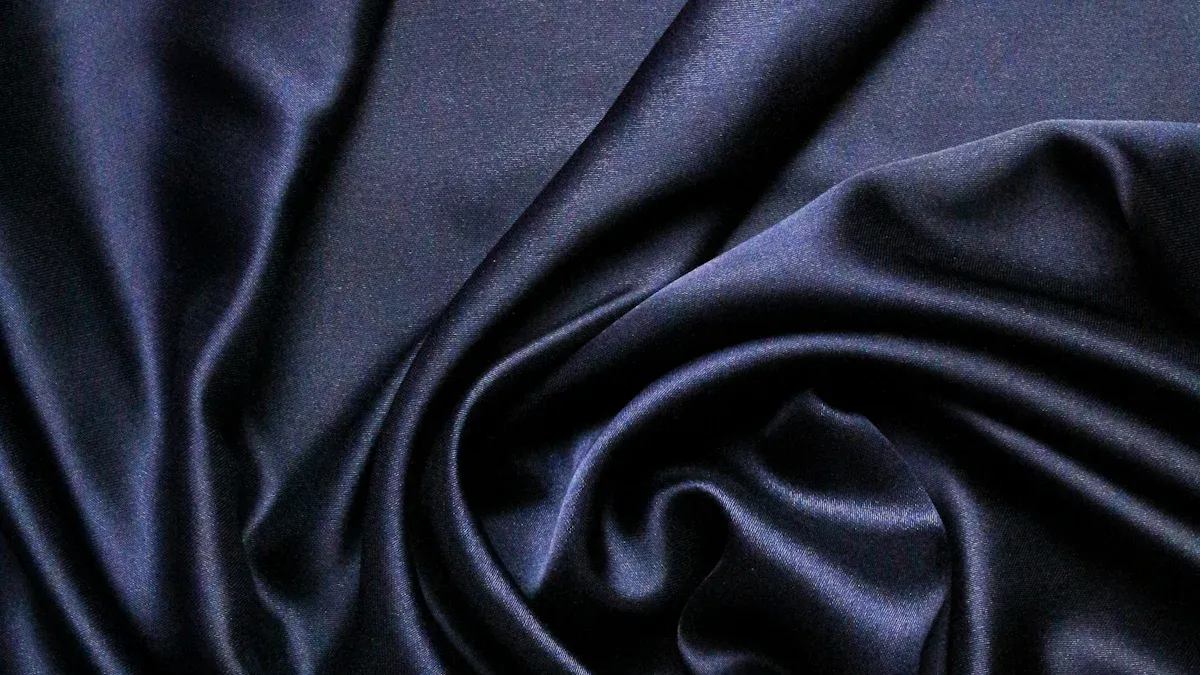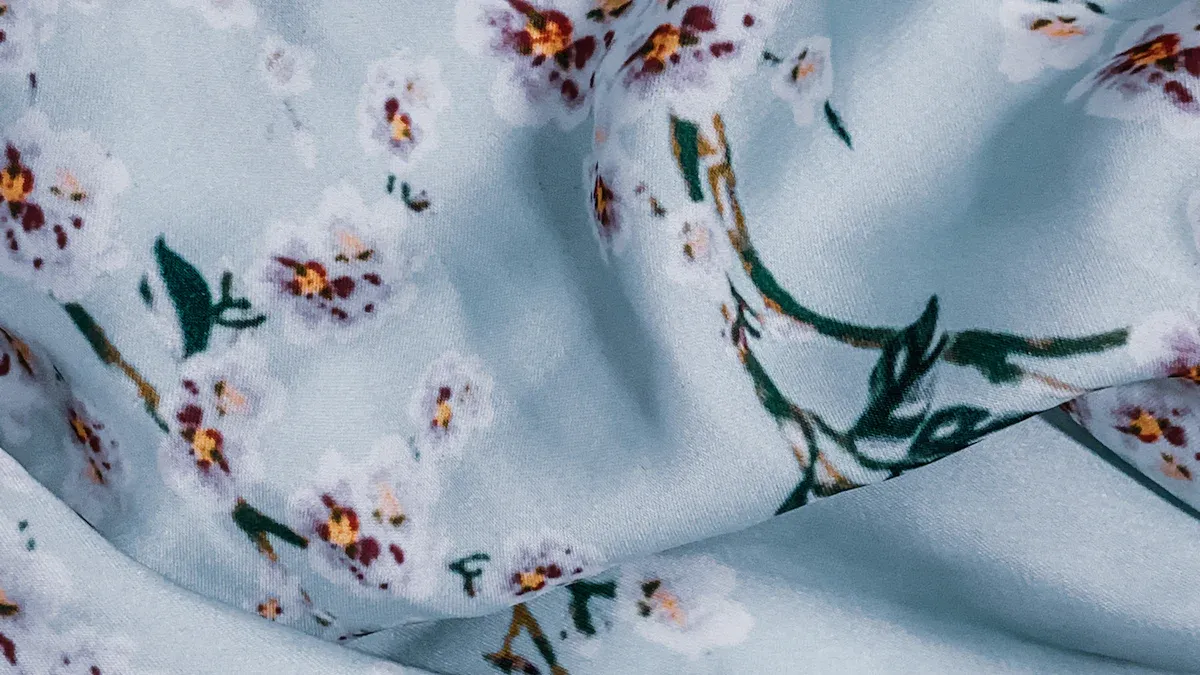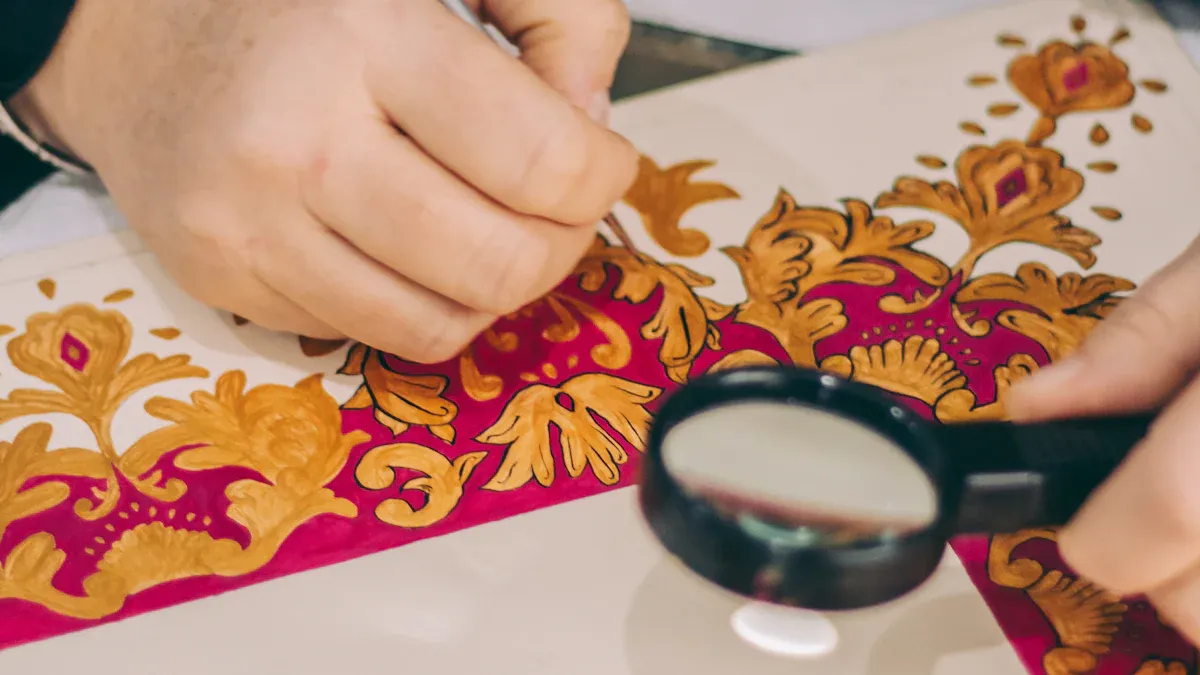
Unlock your creativity with jacquard paint fabric. You can transform any fabric into a unique masterpiece. This tutorial shows you how to use jacquard paint fabric for bold, lasting designs. Choose your favorite fabric and see how easy it feels to create professional results. You get vibrant colors that stay bright wash after wash. With this tutorial, you will master every fabric project from start to finish. Bring your ideas to life and make every fabric piece stand out.
Key Takeaways
- Jacquard fabric paint offers vibrant, long-lasting colors that stay soft and flexible on many fabric types like cotton, polyester, and bamboo.
- Prepare your fabric by washing, ironing, and choosing a tight weave to ensure smooth paint application and lasting results.
- Use thin, even layers of paint and tools like brushes, sponges, and stencils to create sharp designs and avoid cracking or bleeding.
- Heat set your painted fabric with an iron or dryer to lock in color and keep your designs bright and durable after washing.
- Combine Jacquard paint with other techniques like embroidery or dyeing to create unique, personalized fabric art that reflects your style.
Why Jacquard Paint Fabric Stands Out
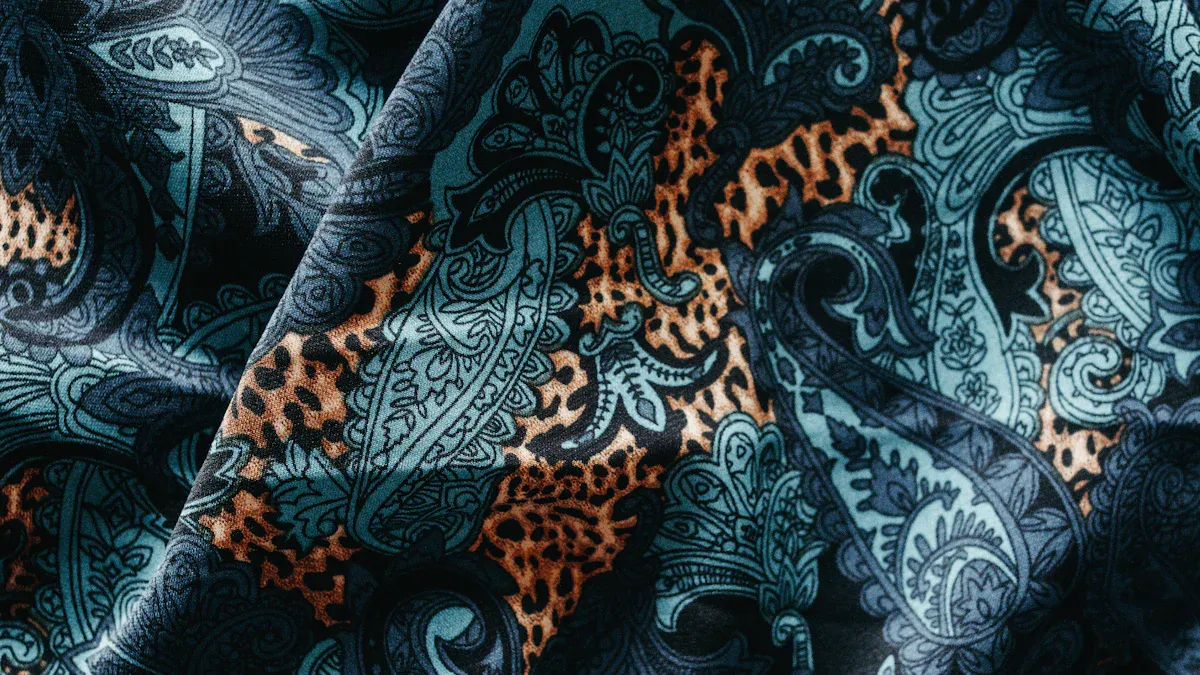
Unique Qualities of Jacquard Fabric Paint
You want your fabric projects to look bold and last a long time. Jacquard paint fabric gives you that power. This fabric paint stands out because it delivers rich color and smooth coverage on almost any fabric. You can use it on cotton, polyester, bamboo, or even leather. The paint stays soft after drying, so your fabric feels comfortable. You get a wide range of colors, from bright primaries to deep metallics. The paint resists fading, even after many washes. You can mix colors to create your own shades. This flexibility makes jacquard paint fabric a top choice for fabric painting.
Types of Jacquard Paint Fabric and Suerte Options
You have many options when you choose Jacquard fabric paint. Each type offers special features for your custom designs. For example, Lumiere gives you metallic and pearlescent effects. Textile Color works well for soft, semi-opaque looks. Neopaque covers dark fabric with thick, bold color. Dy-Na-Flow flows easily on light fabric and feels almost weightless.
Suerte Textile supports your creativity with a wide selection of base fabrics. You can pick polyester knit, bamboo knit, jacquard, rayon blends, and more. Suerte also offers digital printing, embroidery, and dyeing. You get fast sample verification and quick response times. This one-stop service helps you find the best fabric paint and fabric for your project.
Tip: Try mixing different Jacquard paint lines to achieve unique effects and textures on your fabric.
| Jacquard Paint Line | Reported Benefits by Artists and Crafters |
|---|---|
| Lumiere | High-quality metallic and pearlescent effects; excellent adhesion and durability; works on natural and synthetic fabrics including leather; mixable for custom colors and transparency; suitable for dimensional effects. |
| Textile Color | Professional standard; semi-opaque with softness after drying; versatile on many fabric types; can be thinned or made more transparent; intermixable; washable and colorfast. |
| Neopaque | Highly pigmented and fully opaque, ideal for dark fabrics; heavier body but still soft; can be thinned; preferred for full coverage and thicker texture. |
| Dy-Na-Flow | Bodiless, highly saturated and transparent; excellent for light fabrics like silk; very light feel; washfast and durable; compatible with airbrush systems; mixable. |
Benefits for Customizing Fabric
You can transform plain fabric into something special with fabric paint. Jacquard paint fabric lets you create custom designs that reflect your style. The paint bonds well with the fabric, so your art stays bright and sharp. You can use stencils, freehand painting, or even airbrush techniques. The paint works on many types of fabric, so you can decorate shirts, bags, or home décor. You get professional results without needing expensive tools. Acrylic fabric paint from Jacquard gives you the best fabric paint experience. Your designs stay soft, flexible, and colorfast. You can wash your fabric without worrying about fading. With jacquard paint fabric, you unlock endless creative possibilities.
Preparing Fabric and Workspace for Painting
Choosing the Best Fabric for Paint Fabric Projects
You want your custom designs to look sharp and last long. Start by picking the right fabric. Cotton works well for most paint projects. It absorbs paint and holds color. Polyester knit, bamboo knit, and rayon blends also give you great results. Suerte Textile offers many fabric choices, so you can match your vision. Test your paint on a small piece of undyed, bleached, or combed cotton fabric. This step helps you see how the paint reacts and ensures your design will look perfect.
Tip: Choose fabric with a tight weave for crisp lines and even paint coverage.
Prepping Fabric: Washing, Ironing, and More
Proper fabric preparation makes your paint stick better and last longer. Always wash your fabric before you start. This removes oils, dirt, and sizing that can block paint from bonding. Dry and iron your fabric to create a smooth surface. Avoid using fabric softener, as it can leave a residue. For best results, follow these steps:
- Wash fabric in warm water with mild detergent.
- Dry fabric completely.
- Iron fabric flat to remove wrinkles.
- Test your paint on a scrap piece of fabric.
- Use manufacturer-recommended extenders instead of water to thin paint.
- Heat set your paint after it dries. Use an iron for the time listed on the paint label. This step locks the paint into the fabric and boosts colorfastness.
Note: Let your fabric rest after heat setting. This helps the paint bond fully and keeps your design bright after washing.
Setting Up a Workspace for Fabric Paint Success
A good workspace helps you focus and keeps your fabric clean. Choose a flat, stable table with plenty of light. Cover your work area with plastic or a drop cloth to protect surfaces from paint spills. Gather all your tools before you start. You will need brushes, sponges, stencils, and your chosen fabric paint. Keep a roll of paper towels nearby for quick cleanups.
| Workspace Checklist | Why It Matters |
|---|---|
| Flat surface | Prevents paint runs |
| Good lighting | Shows true colors |
| Protective cover | Keeps area clean |
| Tools ready | Saves time |
| Ventilation | Keeps air fresh |
Stay organized and keep your fabric flat while you work. This helps your paint go on smoothly and gives you the best results. With the right setup, you can create stunning fabric art every time.
How to Paint Fabric with Jacquard Paint
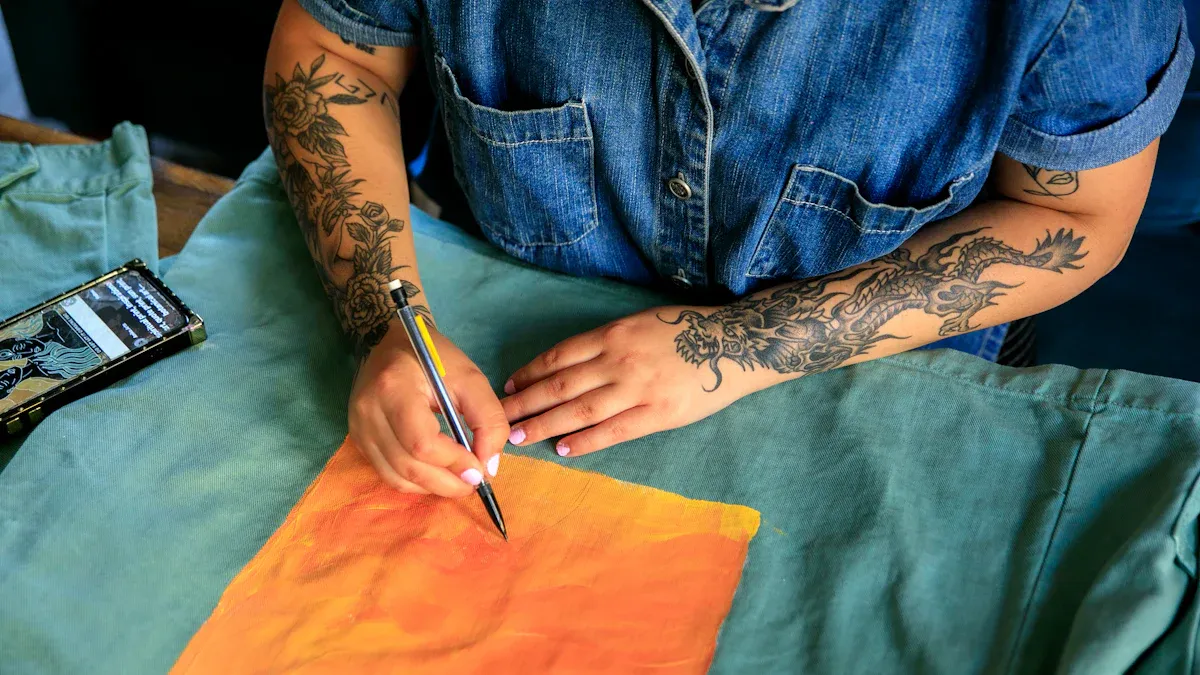
Essential Tools and Materials for Fabric Paint
You need the right tools to master fabric painting. Start with high-quality fabric paint. Jacquard paint fabric gives you vibrant color and a soft finish. Choose brushes in different sizes for detail and coverage. Foam brushes and sponges help you apply paint smoothly. Stencil brushes work well for crisp edges. You also need a palette for mixing color. Use freezer paper or cardboard to protect your workspace and keep fabric flat. Painter’s tape holds stencils and fabric in place. Water and paper towels let you clean brushes and fix mistakes. Always keep a heat source, like an iron or dryer, ready for setting your design.
| Tool/Material | Purpose |
|---|---|
| Fabric paint | Adds color and design to fabric |
| Brushes (variety) | Controls detail, coverage, and texture |
| Sponges/foam | Smooth application and blending |
| Stencil brushes | Sharp edges for stenciling |
| Palette | Mixes and thins paint |
| Freezer paper | Stabilizes fabric, prevents bleeding |
| Painter’s tape | Holds fabric and stencils in place |
| Iron/dryer | Heat sets paint for durability |
Tip: Always test your fabric paint on a scrap piece of fabric before starting your main project. This step helps you see how the color looks and how the paint reacts with your chosen fabric.
Basic Application Techniques for Paint Fabric
You want your design to look smooth and even. Use these basic techniques to get the best results with fabric paint:
- Use a sponge, dauber, or stencil brush. Tap the paint onto the fabric with an up-and-down motion. This method keeps paint from seeping under stencils.
- Apply many thin coats of paint. Thick layers can crack or peel. Thin coats dry faster and give you even color.
- Try sponging, scraping, or stamping. Use tools like old credit cards or plastic knives for unique textures.
- Use freezer paper as a stencil and stabilizer. This keeps your fabric flat and reduces paint bleeding.
- Paint on dry fabric for bold color and sharp lines. Wetting the fabric before painting creates soft, abstract effects.
- Let your painted fabric cure for two to three days. Heat set your design by tumbling it in a hot dryer for 30 to 60 minutes. This step locks in the color and makes your art last.
Note: For metallic colors, dilute the paint well if you want to spray it. Clean the nozzle often to prevent clogging.
These techniques help you control the paint and achieve professional results. You can use them for any fabric painting project, from shirts to home décor.
Advanced Methods: Stenciling, Layering, and Blending
You can take your fabric paint projects to the next level with advanced techniques. Start by washing and ironing your fabric. This step removes sizing and wrinkles, so the paint sticks better. For stenciling, tape or glue your fabric to a board. This keeps it from moving. Use a stencil brush and tap the paint gently. Do not rub, or the fabric may shift. Layering lets you build depth. Paint a light background first. Add stencils or stamps on top. Finish with drawn lines or extra designs for detail. Blending works best when you slightly dampen the fabric. The colors flow into each other for a soft look. Do not soak the fabric, or the paint will run. Use different brushes for shading and coverage. Flat brushes cover large areas. Liner brushes add fine lines. Foam brushes help with blending. Jacquard paint fabric is flexible and non-toxic. Always heat set your finished design to make it permanent.
These advanced techniques let you create multi-layered effects and complex designs. You can combine stenciling, layering, and blending to make your fabric art stand out. This tutorial gives you the skills to use fabric paint as a powerful medium for custom projects.
Callout: Experiment with different techniques and tools. You will discover new ways to express your creativity with fabric paint.
Achieving Even Coverage and Clean Edges on Fabric
You want your custom designs to look sharp and professional. Achieving even coverage and clean edges on fabric makes your work stand out. You can master this skill with the right approach and a few simple tricks.
Start by choosing a smooth, tightly woven fabric. This type of fabric helps the paint glide on evenly. Always stretch your fabric flat before you begin. Use painter’s tape or clips to keep it in place. Wrinkles or folds can cause the paint to pool or bleed.
Apply the paint in thin, even layers. Thick paint can crack or peel after washing. Use a soft brush or foam applicator for smooth coverage. Move your brush in one direction. Overlapping strokes can leave marks. Let each layer dry before adding another. This method gives you rich color without streaks.
For clean edges, use stencils or masking tape. Press the stencil or tape firmly onto the fabric. This step blocks the paint from seeping underneath. Dab the paint gently with a stencil brush or sponge. Avoid brushing back and forth. Lifting the stencil or tape while the paint is still slightly damp gives you the sharpest lines.
Tip: Test your paint on a scrap piece of fabric first. This practice helps you see how the paint spreads and how much pressure to use.
If you want to know how to paint fabric with crisp lines, try these steps:
- Wash and iron your fabric.
- Secure the fabric to your work surface.
- Place your stencil or tape where you want the design.
- Load your brush with a small amount of paint.
- Tap the paint onto the fabric, working from the edges inward.
- Remove the stencil or tape before the paint dries completely.
You can use a table to compare tools for clean edges:
| Tool | Best Use | Result on Fabric |
|---|---|---|
| Stencil brush | Stenciling, small areas | Crisp, defined edges |
| Foam sponge | Large areas, blending | Smooth, even coverage |
| Fine liner brush | Outlining, details | Sharp, thin lines |
You can also use a palette knife for special effects. Drag the knife gently across the fabric for textured lines. This technique works well with thicker paint.
When you learn how to paint fabric with these techniques, you gain control over your designs. You avoid messy edges and uneven color. You make your fabric art look polished and professional.
Callout: Always heat set your finished design. This step locks the paint into the fabric and keeps your edges crisp after washing.
You now have the tools and knowledge to paint fabric with confidence. Clean edges and even coverage turn your ideas into stunning, lasting creations.
Troubleshooting and Pro Tips for Fabric Paint
Fixing Common Paint Fabric Mistakes
Mistakes can happen when you use fabric paint, but you can fix most of them with a few simple steps. If you notice uneven paint or streaks, let the fabric dry. Then, apply another thin layer of paint to even out the color. For paint that bleeds outside your design, use a damp cotton swab to lift the extra paint before it dries. If the paint dries with rough edges, you can touch up the area with a small brush and matching color. When you see cracks in the paint, it often means the layer was too thick. Add a thin coat of fabric paint to smooth the surface. Always let each layer dry before adding more paint. This method keeps your fabric looking clean and professional.
Tip: Always test your paint on a scrap piece of fabric before starting your main project. This step helps you avoid surprises.
Ensuring Colorfastness and Durability on Fabric
You want your custom designs to last. To make sure your fabric paint stays bright and strong, follow these steps:
- Wash your fabric before painting to remove oils and dirt.
- Use thin, even coats of paint for better bonding.
- Heat set your design after the paint dries. Use an iron or dryer as directed by the paint label.
Scientific tests show that dyed fabrics can achieve excellent color retention and durability. Studies using ISO standards found that washing fastness, abrasion resistance, and pilling resistance all scored very high. These results mean your painted fabric can keep its color and resist wear after many washes. You can trust your designs to stay bold and beautiful.
| Step | Why It Matters |
|---|---|
| Pre-wash fabric | Removes barriers to paint |
| Thin paint layers | Prevents cracking |
| Heat setting | Locks in color |
Cleaning and Caring for Painted Fabric
Proper care keeps your painted fabric looking new. Wash your fabric gently in cool or warm water with mild detergent. Choose a gentle cycle for machine washing. Air dry your fabric flat or use low heat in the dryer. Avoid hot water, bleach, and harsh chemicals. These can damage both the fabric and the paint. For delicate fabrics, hand wash with mild soap and cold water. Store your fabric in a cool, dry place away from sunlight. Use acid-free tissue paper if you need to store painted fabric for a long time. When ironing, keep the fabric slightly damp and use low heat to protect the paint and color.
Callout: Gentle care and proper storage help your fabric paint designs last for years.
Creative Applications and Customization Ideas
Pattern and Motif Inspiration for Fabric Paint
You can turn any fabric into a work of art with the right pattern or motif. Try bold geometric shapes for a modern look. Use floral designs if you want something soft and classic. Animal prints add fun to shirts, bags, or pillows. You can even create your own symbols or doodles for a personal touch. Look at nature, magazines, or your favorite art for inspiration. Sketch your ideas on paper before you start painting. This step helps you plan your design and choose the best colors. You can use fabric paint to fill in large areas or add tiny details. Mix and match patterns to make your fabric stand out.
Tip: Use painter’s tape to create sharp lines and borders for your patterns.
Combining Jacquard Paint Fabric with Other Mediums
You can unlock endless creative options by mixing Jacquard paint fabric with other art forms. Try adding embroidery to your painted fabric. This technique gives your project texture and dimension. Dye your fabric first, then use paint to highlight certain areas. Screen printing works well with fabric paint for bold, repeated patterns. These methods let you layer color, texture, and design. You can also blend different Jacquard paint lines, like Lumiere or Neopaque, for special effects. Mix in Pearl Ex powdered pigments for shimmer. Each medium brings something new to your fabric. You get a one-of-a-kind piece that shows your style and creativity.
Callout: Experiment with embroidery, dye, and screen printing to make your fabric art unique.
Project Ideas for All Skill Levels
You can start with simple projects or try advanced ones as you gain confidence. Here are some ideas for every skill level:
- Beginner: Paint a tote bag with your favorite color and simple shapes.
- Intermediate: Create a set of napkins with stenciled motifs and layered paint.
- Advanced: Design a jacket using fabric paint, embroidery, and dye for a mixed-media look.
| Project Type | Skill Level | Materials Needed |
|---|---|---|
| Tote Bag | Beginner | Fabric paint, brushes |
| Napkins | Intermediate | Paint, stencils, sponges |
| Jacket | Advanced | Paint, dye, embroidery kit |
You can use fabric paint on shirts, scarves, pillowcases, or even shoes. Try new techniques and combine different materials. Each project helps you learn more about fabric and paint. You will see your skills grow with every craft you finish.
You can master jacquard paint fabric for custom designs by following a few simple steps.
- Prepare your fabric by tracing your design with a pencil.
- Choose the right fabric and select your paint and brushes.
- Apply paint using dry or wet techniques, depending on your fabric and the effect you want.
- Use stencils for sharp designs and layer colors for depth.
- Let your fabric dry and heat set it to lock in your paint.
- Handle your fabric gently and pick fabric that works well with paint for lasting results.
Try new ideas with fabric and paint. You will enjoy the process and feel proud when you see your unique, professional-quality fabric creations.
FAQ
How do you keep painted fabric soft after using Jacquard paint?
You can keep your fabric soft by applying thin layers of paint. Let each layer dry before adding another. Always heat set your design as directed. This process helps the paint bond without making the fabric stiff.
Can you use Jacquard paint on any type of fabric?
You can use Jacquard paint on many types of fabric. Cotton, polyester, bamboo, and rayon blends all work well. Always test a small area first. Some fabrics absorb paint better and give brighter results.
How do you prevent paint from bleeding on fabric?
You can prevent bleeding by choosing tightly woven fabric. Secure your fabric flat before painting. Use stencils or painter’s tape for sharp edges. Apply paint with a dabbing motion instead of brushing back and forth.
What is the best way to wash painted fabric?
Wash your painted fabric gently in cool or warm water. Use mild detergent. Air dry or use low heat. Avoid bleach and harsh chemicals. This care keeps your fabric design looking new.
Can you combine Jacquard paint with other fabric techniques?
You can combine Jacquard paint with embroidery, dyeing, or screen printing. This mix creates unique effects on your fabric. Try layering different techniques to make your project stand out.


